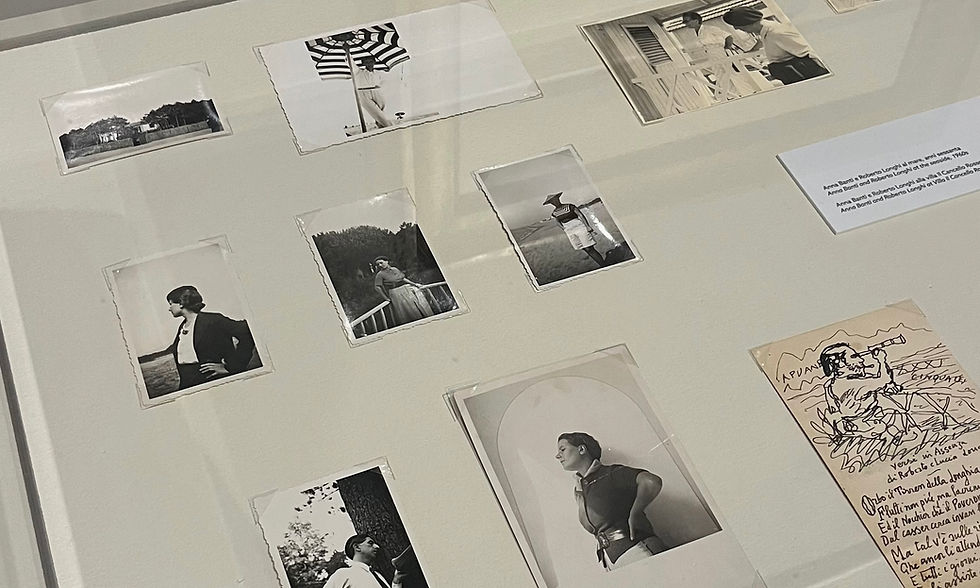Roberto Longhi and Anna Banti: Caravaggio, Artemisia and more
- associazione68
- May 15
- 3 min read
Thursday, 8 May, around 5 p.m., a conference was held entitled Roberto Longhi e Anna Banti: Caravaggio, Artemisia e non soltanto. Delivered by Cristina Acidini, writer, art historian, and a key figure in the conservation and promotion of Florence’s cultural heritage, the presentation aimed, among other things, to introduce the exhibition Caravaggio e il Novecento. Roberto Longhi, Anna Banti, taking place from 27 March to 20 July 2025 at the Villa Bardini in Florence.

A Mirrored Couple
Roberto Longhi (1890–1970) and Anna Banti (1895–1985) met at the Tasso secondary school in Rome, when Longhi had just begun his career as an art history teacher. He was 23; Anna Banti – then known by her birth name, Lucia Lopresti – only 18. “Also an art historian, she quickly realised that beside Longhi, her role would be secondary. So she chose another path: writing,” stated Cristina Acidini. Yet this distinction, also present in the journal Paragone, which the two intellectuals co–founded, in no way signaled a rupture or indifference, but rather the possibility of an ongoing dialogue between two forms of intellectual expression. In this sense, while Longhi is renowned for his studies on Caravaggio (1571–1610), Anna Banti – who adopted her pen name of a childhood friend – rediscovered, through literary fiction, the life of an equally significant painter of the Renaissance, Artemisia Gentileschi (1593–1653).
From Villa Il Tasso to the welcoming of doctoral students
The conference opened with a focus on the couple’s former residence, Villa Il Tasso, and especially their shared working space. Comprising both a library and a photo archive, it provided the ideal setting for in–depth art historical research, particularly at a time when such photo archives were, according to Cristina Acidini, genuine “instruments of power” due to their rarity and the wealth of research opportunities they afforded in terms of image consultation and painting analysis. Only a handful of art historians had access to such resources, among them Bernard Berenson, Federico Zeri, and Giuliano Briganti.
Today, Villa Il Tasso houses the Longhi Foundation, which, true to Longhi’s wishes, aims to preserve this heritage for future generations, particularly young researchers in art history. Some of them, supported by research fellowships, are fortunate enough to access the Foundation’s full resources, including the archives, library, photo library, and the art collection.
A dandy and his circle of friends

The couple paid great attention to their image, often photographing themselves, even in the 1930's during their holidays in Poveromo, in the province of Massa–Carrara. The current exhibition at Villa Bardini includes a notable number of these photographs, which is particularly remarkable for the time. Longhi, specifically, stood out with his dandy–like appearance, a sharp gaze, and frequently, a cigar at the tip of his lips. For Amélie Zimmermann, a former student of the École Normale Supérieure specialising in the philosophy of fashion, the figure of the dandy is not merely aesthetic but holds within it the secret of revolt, of asceticism, of a spiritual and moral foundation: the idea of making life itself a work of art. Baudelaire wrote of the dandy as “a setting sun, like a declining star, splendid, without warmth, and full of melancholy,” and in listening to the words of Pasolini, who was once Longhi’s student at the University of Bologna, one cannot help but draw a parallel, as he described the art historian not so much as a star, but as “an apparition.”
Questions of cultural mediation
Although the exhibition’s title includes references to both Caravaggio and Anna Banti, it is Longhi who takes centre stage. Only one painting by Caravaggio is present in the exhibition, a mythic work depicting a young boy bitten by a lizard, symbolising a reaction to the discovery of time, of impermanence, and by extension, of the nature of desire. Yet Cristina Acidini herself raised the question: why give precedence to Caravaggio amid dozens of other exhibited works? Could it be an attempt to position Florence in contrast to Rome and his exhibition entitled Caravaggio 2025? Numerous cultural mediation issues arise here – with the art historian even revealing that some members involved in the exhibition’s communication had considered titling it From Caravaggio to the Twentieth Century. However, “Longhi had no particular affection for the 19th century so it could not be a chronological exhibition”, Cristina Acidini considered.
More broadly, the exhibition also reveals an imbalance in attention between Longhi and Banti, as the writer’s dedicated space is notably smaller than that of her husband. And yet, it is she, whose understated feminism shines through her novels, who currently sparks the greatest interest among scholars and doctoral students. Proof, if any were needed, that we still have a lot to learn from the academic eye.
Alan B.




Comments